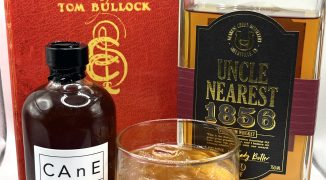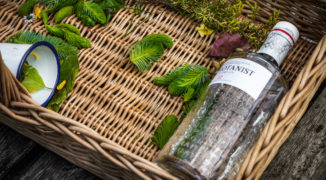The Bee’s Knees, hot toddies, the Penicillin—even mead. Honey and alcohol have a rich history, and, it seems, a very interesting future. Today, the flavor possibilities of different honey varietal and spirit pairings are extremely nuanced, creating fertile territory for region-specific cocktails and deeper layers of flavor.
As both honey and spirits have been taken more seriously since their artisanal makeovers, the National Honey Board hired Kim Haasarud, a master mixologist and beverage consultant, to look at specific pairings.
“We heard that Kim was working with honey and cocktails, and we’d just put together a honey cocktail guide,” says National Honey Board spokesperson Andrea Schepke. “We invited her to a honey summit and she got to learn more about the different honeys, and we thought it would be interesting to look into the different varietals and how they paired up with different spirits.”
For Haasarud, it was a means of deepening her base understanding of how to use honey with spirits. “I’ve always used honey in cocktails since I’ve been making them, for it’s used in many classic cocktails such as the Bee’s Knees,” she notes. “But it really wasn’t until I started delving into using all the various honey varietals with spirits that Pandora’s box really opened. It was about a year and a half ago when I started playing around with pairing various varietals with gin, for example, and not just any gin, but many types of gins—mind-blown.”
While there are over 300 honey varietals produced in the United States, all sourced from different flowers or flower combinations, Haasarud focused on the five that are most accessible to mixologists: Orange Blossom, Clover, Alfalfa, Wildflower, and Buckwheat. “She played with those and how they paired across the different spirit categories,” Schepke said.
Each of these honeys was paired with vodka, gin, rum, tequila, whiskey, Scotch, and Cognac. Within the spirits, the subcategories of grain versus potato vodka, dark rum versus white rum, and so forth were also considered. It’s an in-depth exploration of this complex sweetener’s distinct possibilities when considered on its own terms.
Popularly considered a sweetener to be used in specific, often more therapeutic applications, honey has a terroir that can, Schepke says, “inspire a regional take on cocktails. It can add to the story.”
“The honey flavor can change depending on the flower, the blossom. Wildflower honey—it’s kind of the free-range honey,” as opposed to Orange Blossom honey, for instance, which is made from the nectar of bees who are only exposed to orange trees. Schepke explains: “If there are multiple sources, different kinds of flowers in the two-mile radius or so that bees can travel to collect their nectar, that would be described as wildflower honey from the different region. They tend to be very interesting and complex and have a lot of different layers.”
Haasarud echoes these reasons to choose it for sweetening: “Honey is better than simple syrup because it’s all-natural. One great thing to do is go to your farmers’ market and pick up some honey there. That way you’re sure to buy honey local, and it also incorporates local flavor. Here in Arizona, Mesquite honey is quite popular and readily available—it tastes like the desert.” According to her, most commercial kitchens buy clover honey, which is heavier in flavor, thus leading to the perception that to use honey, one must want to taste it explicitly.
The overall takeaway of Haasarud’s research was that lighter honeys pair better with lighter spirits and darker honeys pair better with darker spirits. A floral gin goes well with an Orange Blossom honey, as a Buckwheat honey—with notes of chocolate, coffee, and molasses—complements a single malt Scotch. If one were creating a more vegetal cocktail, an Alfalfa honey, with its grassy undertones, would be the right choice.
“I think what surprised me most was how the different varietals could be used to enhance a spirit,” Haasarud said of these findings. “A clover honey has more vanilla, maple-y flavors that can actually mimic some of the same notes and flavors that come from a barrel, so I can make an un-aged tequila taste like a reposado or anejo tequila by changing the honey varietal.”
While the best pairing is up to your palate, Scotch and honey yielded some especially superb results. “One would even say that many scotches have flavors and nuances of honey in the spirit itself,” Haasarud said. “Honey really calms that smoky peatiness and can actually extend that flavor in a long, silky finish that is really beautiful.”
She also recommends using honey as a garnish—“ranging from honeycomb to honey crystals to honey sticks to honey foams to making a honey brittle.”
Haasarud sees exciting, endless possibilities for honey and spirit pairings. “I think we’re going to start seeing a lot more honey used in cocktails, not just as a sweetener anymore, but as an enhancer,” she said. With its local availability and less processed production, different honey varietals look like they’re becoming a more necessary part of a well-stocked cocktail arsenal.





